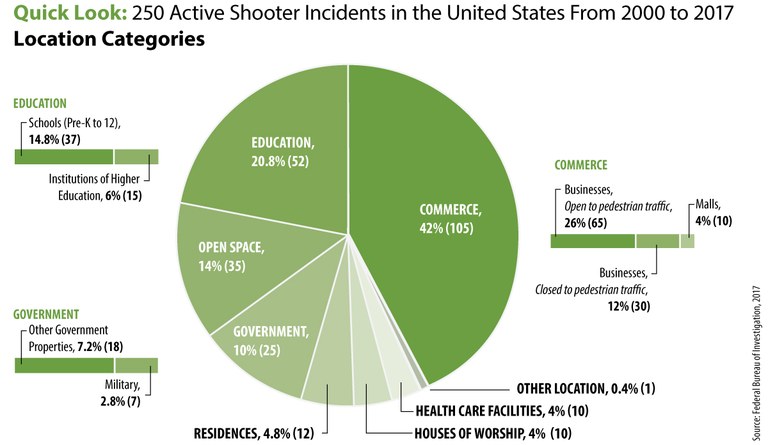The United States is in the midst of a significant uptick in active shooter events which, despite a slight drop in 2018, is still at historically high levels. More troublesome are the number of people killed during these shootings, which climbed from 214 in 2016 to 729 in 2017.
Security agencies for the government define an active shooter incident as “an individual actively engaged in killing or attempting to kill people in a confined and populated area.”
And while schools, courthouses, and places of worship have become targets of shooters in recent years, none have sustained as many attacks as commercial entities – which is to say, office spaces and retailers. Analysis by one organization of active shooter incidents between 2000-15 found that more than half involved a business.
Why Target Businesses?
So why is it that so many businesses experience active shooter events? The answer, as you might expect, is a bit complex.
First, most active shooters look for so-called ‘soft targets,’ which is to say, locations that are both densely populated and lack controlled access or obvious security measures. Which helps to explain why commercial institutions, which by their very nature are ‘open for business,’ can be ideal locations for a shooter to do great damage.

Two examples of soft targets: On July 20, 2012, James Holmes set off tear gas canisters in an Aurora, Colorado, theater before opening fire on the stunned audience. Holmes ultimately would kill 12 and injure 70. And on June 12, 2016, Omar Mateen shot and killed 49 people and wounded another 53 in an Orlando, Florida, nightclub.
Theaters, night clubs, restaurants, and similar businesses are ideal targets for active shooters, because they’re packed with people, often lack security (especially armed security), and they’re open to anyone.
Another reason active shooters target businesses is because they’re in some way disgruntled or angry with someone inside or simply the institution itself. Terminated or disgruntled employees, unhappy customers, spurned contractors – the shooter feels wronged by the business and is determined to exact his revenge (active shooters are almost always male).
What Can a Business Do?
While no strategy is full-proof when it comes to thwarting active shooters, security experts say there are steps businesses can take to mitigate today’s active shooter threat.
Because many active shooters hold a grudge against a business, a key first step is for companies to become more conscious of the threat that an angry ex-employee or contractor may pose. This might include creating a more formal means of identifying these individuals through record-keeping software, monitoring their activities on social media (most active shooters leave a social media trail intimating their intentions), and even reporting suspicious or threatening behavior to police.
On that same note, there are companies offering predictive intelligence services, which will monitor and analyze social media posts for potential threats or signs of risky behavior.
Similarly, encourage a culture of openness, wherein employees are free to report odd or suspicious or threatening behavior by an employee, ex-employee, contractor, or anyone else engaged with the business. It’s a new day, argue security experts, and in the same way we no longer can ignore a bag or suitcase left unattended, we no longer can ignore odd or threatening behavior by others.
Deterrence is the best strategy, and as noted above, if it’s feasible for a business to do so, limiting access through automated entry systems or security checks will at least give shooters pause. An armed guard is an even better option, though most businesses cannot afford such an option.
Businesses also need to consider establishing safe rooms and tactics for getting employees and customers into them as quickly as possible. Storage rooms, back offices, kitchens, etc., can be outfitted with heavy-duty doors and automated alarm systems.
On that same note, in the same way that schools now practice active shooter training for teachers and students, businesses, too, should begin creating and regularly review active shooter responses for staff.
Last but not least, businesses should consider safety training for their employees – particularly in instances where self-defense is required. A growing number of security experts not only are advising women to actively fight back against rapists, but for employees to do the same.
Jeff Cooper, author of Principles of Defense, urges those without any other recourse, to fight back with “aggressiveness, speed, ruthlessness, and surprise.” More than half of active shooter events end before police arrive, often because victims took the offensive and overwhelmed the shooter or otherwise stunned him.
The bottom line for businesses: we are in a new world where active shooting events, though still rare, are increasingly commonplace. As such, it is incumbent on business owners and executives to ensure their employees have a plan of response in the event an active shooting event takes place.


Leave A Comment
You must be logged in to post a comment.